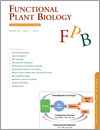
Functional Plant Biology
Volume 45 Number 7 2018
FP17071Concerted anatomical change associated with crassulacean acid metabolism in the Bromeliaceae
CAM is a flexible photosynthetic mode conferring robust environmental resilience. This investigation tackles the scarcity of data linking anatomical evolution and CAM function, showing that in a diverse family, co-option and augmentation of existing succulence was integral to multiple CAM origins. The results clarify the evolution of CAM and also help define the baseline level of cell and tissue succulence required in efforts to bioengineer CAM into food and biomass crops.
FP17278Dynamic analysis of the impact of free-air CO2 enrichment (FACE) on biomass and N uptake in two contrasting genotypes of rice
Elevated [CO2] increases rates of photosynthesis and crop yields, but the degree of enhancement varies among cultivars. The present study indicates that the more effective use of CO2 in IIY compared with WYJ results in a strong response in root growth, nitrogen uptake, and in yield, N synchronises biomass responses between shoot and root. Our findings help clarify key mechanisms by which elevated [CO2] elicits differential growth and yield responses among cultivars in rice.
FP17227Counting the costs: nitrogen partitioning in Sorghum mutants
Sorghum synthesises the specialised metabolite dhurrin, which, when enzymatically hydrolysed releases hydrogen cyanide, which is toxic to grazing animals. We used dhurrin deficient mutants to test growth–defence trade-offs at different nitrogen fertiliser levels. Plants lacking dhurrin were slower growing as seedlings but had a growth advantage at later developmental stages, suggesting a benefit of dhurrin in early growth but a cost at later stages. To maintain global food security, crop yields must be optimised while resource input is minimised.
FP17161Pearl millet (Pennisetum glaucum) contrasting for the transpiration response to vapour pressure deficit also differ in their dependence on the symplastic and apoplastic water transport pathways
Differences in plant hydraulics may explain an important phenotype for drought adaptation: saving water by restricting the transpiration rate, especially under high vapour pressure deficit (VPD). Soil grown roots limited high VPD transpiration, even more so in low Tr genotype. Root water transport was more apoplastic in low Tr genotype and more symplastic in high Tr genotype. These were hypothesised to ‘tune-up’ the aquaporin-mediated symplastic pathway under high VPD.
FP17304Selection of optimal reference genes for quantitative RT-PCR transcript abundance analysis in white clover (Trifolium repens L.)
Quantitative reverse transcription PCR, a widely used technique for measuring the transcriptional activity of genes, is critically dependent upon the use of reference genes. This manuscript is the first reported systematic search for reference genes in the commercially important forage legume white clover. Three genes, out of seven evaluated, were identified as reliable references, paving the way for future work on any gene in white clover.
FP17127Enhancing antioxidant systems by exogenous spermine and spermidine in wheat (Triticum aestivum) seedlings exposed to salt stress
Salinity stress is one of the major limitations to crop productivity worldwide. The aim of the present study was to understand the functional role of spermidine and spermine with respect to salt stress in wheat seedlings. Our results show that exogenous spermidine and spermine effectively up-regulated transcriptional levels of antioxidant enzyme genes and improved the defence response of plants under salt stress.
FP17209Linking root traits to superior phosphorus uptake and utilisation efficiency in three Fabales in the Core Cape Subregion, South Africa
Dwindling phosphate reserves and the high costs of P fertilisers drive the need to develop more P-efficient crops through enhancing P uptake. We expected that Aspalathus linearis, a cluster-root-forming species, would be better at P acquisition than other species. Polygala myrtifolia, however, developed a root system with better P uptake traits and had a higher P uptake efficiency. Therefore, other root traits besides cluster roots are important for enhancing P uptake in plants.
FP18014Grapevine fanleaf virus affects grape (Vitis vinifera) berry anthocyanin content via the transcriptional regulation of anthocyanin biosynthetic genes
Grapevine fanleaf virus (GFLV) causes grapevine fanleaf degeneration, one of the oldest known viral diseases of grapevines. Our research showed that GFLV infection caused a drop of the yield due to both a reduction of cluster weight and berry weight. GFLV infection also affected the berry composition due to increase of anthocyanin concentration and modification of proportions between di- and tri-, hydroxylated or methylated derivatives of anthocyanins, due to modified expression of F3ʹ5’H, F3ʹH and F3H1 genes.



